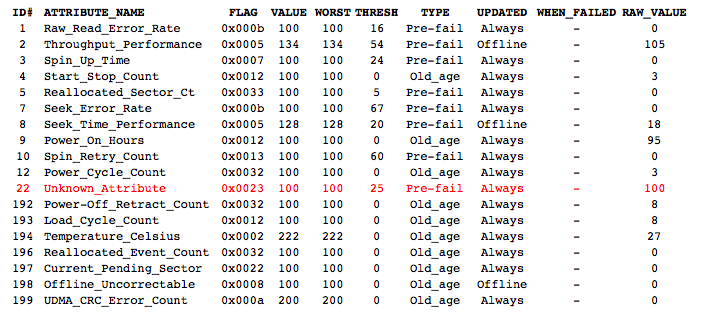
We recently filled a Backblaze Storage Pod with 45 HGST Ultrastar® He8 hard drives. For the uninitiated, these are 8TB drives filled with helium. The helium, so says the literature, allows the drives to run cooler and quieter, and reduces power consumption.
When we wire up a new hard drive model into our infrastructure, one of the things we need to do is figure out which SMART attributes the drive reports, since nearly every different drive model reports a slightly different set of attributes. Below are the first few SMART attributes reported by one of the 8TB HGST drives:

The attribute highlighted in red is SMART 22, and we had never seen that one before. We researched this “Unknown_Attribute” and couldn’t find anything online so we asked the HGST folks. They responded by saying that attribute 22 is the status of the helium in a drive. It is a pre-fail attribute that trips once the drive detects that the internal environment is out of specification. They did not share the amount of helium in a given drive or the “trip points” related to the amount of helium although there is a normalized threshold value of “25” listed.
We’ll be monitoring this Helium filled Pod over the next several weeks and let you know how things go. In the meantime, feel free to impress your colleagues with your newfound SMART 22 knowledge. And just for fun, here are a handful of helium facts…
- The atomic number of helium is 2.
- Helium is the second most abundant element in the universe with helium atoms making up a quarter of the mass in the Universe, but it is much less common on Earth.
- Helium is so light that Earth’s gravity is not strong enough to hold on to it. When helium atoms are released into the atmosphere, they rise until they escape into space.
- Helium exists in Earth’s atmosphere only because it is constantly resupplied from two sources—decay of radioactive elements on Earth, and cosmic rays, about 9% of which are high-energy helium nuclei.
- The helium we buy in cylinders is produced by the natural radioactive decay of radioactive elements in the earth’s crust—principally thorium and uranium.
- Current world production of helium is over 30,000 metric tons a year. Helium has been accumulating for many millions of years in a few natural gas fields, therefore we can currently extract more each year than is being created by uranium and thorium decay.
- Helium is colorless, odorless, tasteless, non-toxic, and inert.
- Helium makes up 0.0005% of all the air we breathe!
- Inhaling helium temporarily changes the sound of a person’s voice. Though helium is non-toxic, breathing it can result in asphyxiation due to oxygen deprivation.
- At temperatures close to absolute zero, helium condenses to a liquid with amazing properties—the properties of a superfluid, flowing with zero friction up and over the walls of containers.
Sources:
- www.chemicool.com/elements/helium-facts.html
- chemistry.about.com/od/elementfacts/a/10-helium-facts.htm
FYI, if the helium drives don’t work out, we’ve got another use for the helium.





